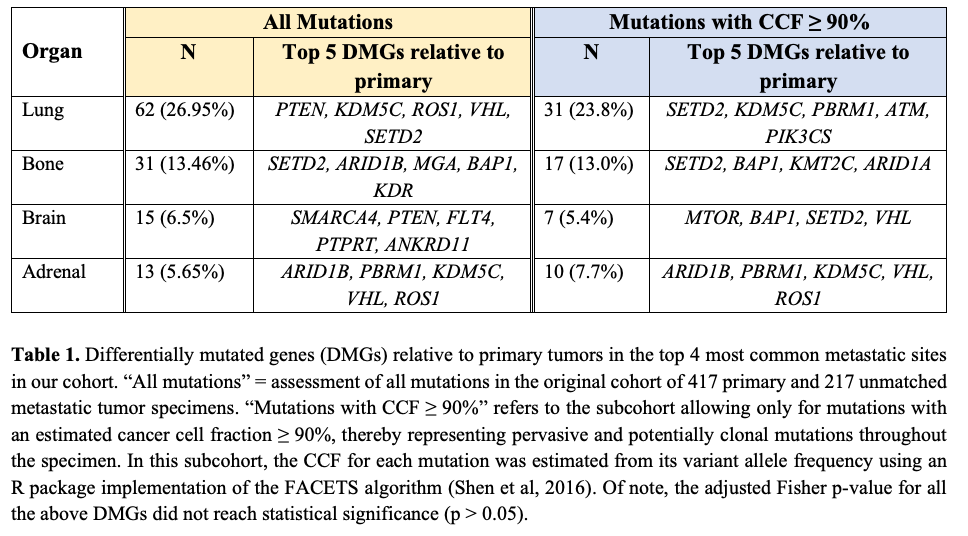Back
Poster, Podium & Video Sessions
Podium
PD01: Kidney Cancer: Basic Research & Pathophysiology I
PD01-08: Comparison of Mutational Profile of Primary versus Organ-specific Metastatic Tumors in Clear Cell Renal Cell Carcinoma
Friday, May 13, 2022
8:10 AM – 8:20 AM
Location: Room 252
Sari Khaleel*, New York, NY, Renzo DiNatale, Seattle, WA, Benjamin Freeman, Ritesh Kotecha, Robert Motzer, Paul Russo, Jonathan Coleman, Eduard Reznik, Ari Hakimi, New York, NY

Sari S. Khaleel, MD, MSC
MSKCC
Podium Presenter(s)
Introduction: While the mutational profile (MP) of primary clear cell renal cell carcinoma has been well described, the MP of metastatic ccRCC tumors remain less clear, particularly for organ-specific metastases. We sought to compare the MP of primary tumors to organ-specific metastases in ccRCC.
Methods: Targeted next generation sequencing data comprising the MPs of 417 primary and 217 unmatched metastatic ccRCC specimens were retrieved from our institutional database. Differentially mutated genes (DMGs) in metastatic relative to primary specimens were identified, as well as DMGs for the cohort’s 4 most common metastatic sites. We then repeated our analysis focusing on mutations with a corresponding estimated cancer cell fraction (CCF) of = 90% in their tissue specimen, suggesting that these mutations are pervasive clonal mutations of higher clinical relevance. Analyses were performed using R v4.0.4 (The R Foundation for Statistical Computing).
Results: Primary tumors had significantly higher tumor purity (TP) and lower mutational burden (TMB) compared to metastases (51.3% vs 47.36%, p = 0.049; 56.4 vs 67.2 mutations/Mb, p < 0.001, respectively). Relative to primary tumors, the top 3 DMGs in all-metastases were SETD2, PTEN, and KMT2D (adjusted Fisher p-value < 0.05). The top 4 metastatic sites were lung, bone, brain, and adrenal, with a distinct set of DMGs for each site, although none reached statistical significance (p > 0.05; Table 1). Focusing on samples with mutational CCF = 90% reduced our cohort size to 284 primary and 130 metastatic tumors, with no statistically significant changes from the original cohort’s age, gender, TP or TMB distributions. Relative to primary tumors, the top DMG profile in all-metastases remained unchanged in this subcohort, with some differences in the DMG profile of site-specific metastases, although none reached statistical significance (p > 0.05).
Conclusions: Mutational profiles of ccRCC vary between primary and metastatic tumors, and among different metastatic tumor organ sites. This could have potential downstream implications for the prognosis and therapeutic response of these tumors, as their response to targeted therapies may be affected by the genomic context of their background tissue.
Source of Funding: None

Methods: Targeted next generation sequencing data comprising the MPs of 417 primary and 217 unmatched metastatic ccRCC specimens were retrieved from our institutional database. Differentially mutated genes (DMGs) in metastatic relative to primary specimens were identified, as well as DMGs for the cohort’s 4 most common metastatic sites. We then repeated our analysis focusing on mutations with a corresponding estimated cancer cell fraction (CCF) of = 90% in their tissue specimen, suggesting that these mutations are pervasive clonal mutations of higher clinical relevance. Analyses were performed using R v4.0.4 (The R Foundation for Statistical Computing).
Results: Primary tumors had significantly higher tumor purity (TP) and lower mutational burden (TMB) compared to metastases (51.3% vs 47.36%, p = 0.049; 56.4 vs 67.2 mutations/Mb, p < 0.001, respectively). Relative to primary tumors, the top 3 DMGs in all-metastases were SETD2, PTEN, and KMT2D (adjusted Fisher p-value < 0.05). The top 4 metastatic sites were lung, bone, brain, and adrenal, with a distinct set of DMGs for each site, although none reached statistical significance (p > 0.05; Table 1). Focusing on samples with mutational CCF = 90% reduced our cohort size to 284 primary and 130 metastatic tumors, with no statistically significant changes from the original cohort’s age, gender, TP or TMB distributions. Relative to primary tumors, the top DMG profile in all-metastases remained unchanged in this subcohort, with some differences in the DMG profile of site-specific metastases, although none reached statistical significance (p > 0.05).
Conclusions: Mutational profiles of ccRCC vary between primary and metastatic tumors, and among different metastatic tumor organ sites. This could have potential downstream implications for the prognosis and therapeutic response of these tumors, as their response to targeted therapies may be affected by the genomic context of their background tissue.
Source of Funding: None


.jpg)
.jpg)